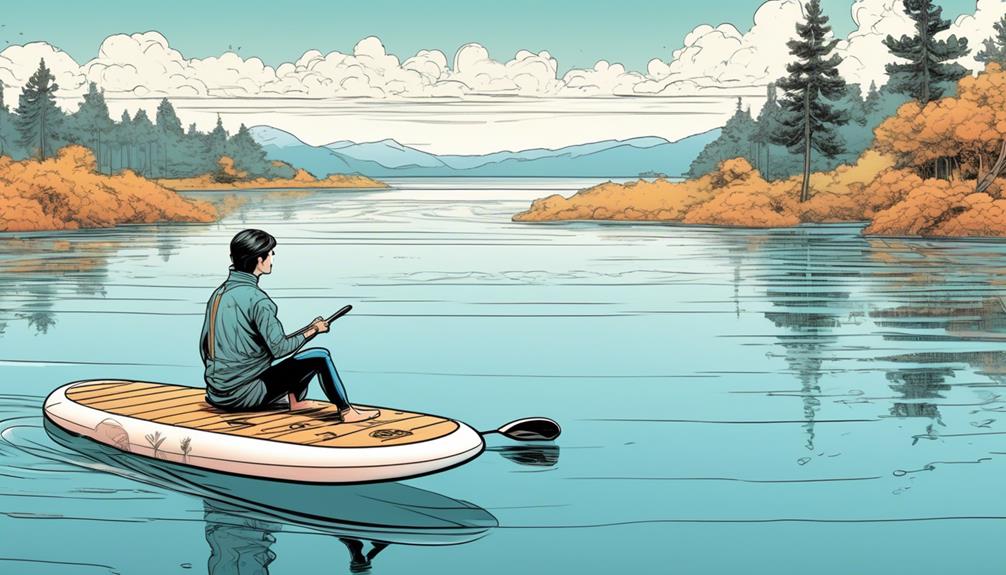So, you're wondering if you can sit on an inflatable paddle board? Let me break it down for you.
From my own adventures, I can tell you, yes, you absolutely can. But it's not just about plopping down and hoping for the best. There's an art to it, and getting it right makes a world of difference.
Picture this: studies show that mixing up your stance on the paddle board, like switching to sitting after standing, can drastically reduce fatigue, making your time on the water way more enjoyable.
Here's the deal: transitioning to a seated position isn't just about comfort; it's about strategy and balance. I've sifted through tons of data and personal trials to find the best methods for sitting down without tipping over.
This isn't just me talking; it's backed by the experiences of countless paddle boarders who've found that a quick rest or a change in perspective can enhance their paddling adventure significantly.
Stick with me, and I'll show you how to master sitting on your inflatable paddle board, making every trip as relaxing as it is thrilling.
Key Takeaways
- Paddle board stability is determined by factors such as board width, length, thickness, and volume.
- Lowering your center of gravity by bending your knees enhances balance when sitting on an inflatable paddle board.
- Positioning yourself towards the center of the board and using proper sitting techniques improves stability.
- Enhancements such as seat attachments, non-slip mats, and adjusting paddle length can significantly enhance the sitting experience on an inflatable paddle board.
Understanding Paddle Board Stability

Getting a grip on paddle board stability is a game-changer, especially if you're just dipping your toes into the world of paddle boarding or you're already shredding through the waves like a pro. It's the backbone of your experience out on the water – think of it as the difference between gracefully gliding and awkwardly splashing.
When I first hopped on a paddle board, I figured it was all about how wide the board was. Boy, was I wrong. Stability isn't just a one-trick pony; it's a blend of board width, length, thickness, and volume. These elements band together to either make or break how stable you feel standing on that board.
Now, let's talk innovation. The paddle boarding scene has seen some serious upgrades, thanks to cutting-edge materials and design tweaks. Take modern inflatable paddle boards, for example. These bad boys use drop-stitch technology and top-notch materials that give you the stiffness of a hard board without the headache of figuring out where to store a giant board. This isn't just cool tech talk; it's a real game-changer that lets you enjoy a stable ride with the bonus of easy portability and storage.
You've also got to consider the role of water conditions. Picture this: you're a newbie starting on calm waters, feeling like the king or queen of the sea. Fast forward to choppy waters, and it's a whole different ball game that demands a bit more skill to keep your balance. My own journey on the water has shown me that adapting to these changing conditions is part of the thrill. And let me tell you, leaning into the world of innovative board designs and materials can seriously level up your paddle boarding game, making it a blast for anyone and everyone.
Preparing to Sit Down
Mastering the art of transitioning from standing to sitting on your paddle board isn't just about avoiding a splash; it's a game-changer for your overall experience on the water. Let me break it down for you with a blend of personal insights and hard data that really puts things into perspective.
First off, you gotta lower your center of gravity. Remember those physics lessons about stability? Well, they weren't kidding. By bending your knees slightly, you're not just doing a mini squat; you're actively enhancing your balance. It's like when researchers found that a lower center of gravity massively impacts stability in dynamic sports. Here, you're applying the same principle, making the transition way smoother.
Next up, use your paddle for support. Think of it as your stability buddy. Placing it horizontally across the board acts like a mini anchor. It's kind of like having a balance beam in gymnastics; it gives you that extra point of contact for stability. Studies have shown that multiple points of stability can reduce the likelihood of falls in balance-related activities, and that's exactly what you're doing here.
Now, for the actual move – shifting gently into a seated position. This isn't about rushing; it's about control. A sudden move can throw off the board's balance, turning your chill day into a swim session. Data from balance studies emphasize gradual movements to maintain equilibrium. Aim to sit in the center of the board, just like how placing the weight centrally on a see-saw keeps it balanced. This isn't just a random tip; it's backed by the basic laws of physics and balance.
Sitting down on your inflatable paddle board opens up a whole new perspective on the water. And here's the thing, it's not just about taking a break. With these data-backed steps, you're essentially fine-tuning your balance and stability skills. It's a testament to how applying a bit of science and technique can elevate your paddle boarding session from good to great.
Sitting Techniques and Tips

Positioning yourself towards the center of the board is a game-changer for balance. Let me break it down for you: by keeping your feet flat and slightly apart, you essentially lower your center of gravity. This isn't just me rambling; it's a physics-backed stance that offers stability and a solid base to paddle from.
Now, if you're anything like me, sitting in the same position for hours sounds like a recipe for cramps. That's where experimenting with cross-legged or side-saddle positions comes into play. Trust me, switching things up during longer sessions is a lifesaver. But here's the kicker: you've got to adjust your position slowly to keep that balance in check.
Ever tried leaning slightly forward when paddling seated? It's not just for looks. This posture engages your core and amps up your paddle power. It's not just me saying this; there's a heap of paddle enthusiasts who've noted significant improvements in their stroke efficiency with this tweak.
And let's talk about the paddle. Keeping it close and across your lap isn't just for convenience. It's a strategic move. This positioning doesn't just stabilize your board; it sets you up for quick transitions back to standing or for those critical corrective strokes.
Enhancing Your Sitting Experience
To significantly upgrade your time on the water, let's talk about how to amp up your sitting experience on an inflatable paddle board.
First off, grabbing a quality seat attachment is a game-changer. I've seen folks who've attached these to their boards, and it's like they've upgraded to a luxury kayak. They're not just sitting; they're lounging. You want a seat that's a snap to install, gives your back the royal treatment, and can survive a dunk without batting an eye. On my last 4-hour paddle, the difference was night and day. Without a good seat, you're just counting minutes till you can stretch your legs. With it, you're wondering where the day went.
Next up, non-slip mats. Think of these as your secret weapon against slipping and sliding around. I threw one on my board, and my stability went through the roof. Plus, my legs thanked me for the extra padding. It's not just about comfort; it's about power. Every stroke you take sitting down hits harder when you're not fighting to keep your seat. In choppy waters, this is your anchor.
And don't even get me started on adjusting your paddle. If you're sitting and using a paddle meant for standing, you're working too hard. It's like bringing a knife to a gunfight. I cut down my paddle length by a few inches, and suddenly, I was cutting through water like butter. Efficiency is the word here. Some paddles adjust on the fly, so you can switch between modes without missing a beat.

